Littlehead porgy
The littlehead porgy (Calamus proridens) is an ocean-going species of gamefish of the family, Sparidae. It is only found in the western portion of the tropical Atlantic Ocean, where they are often caught and used as food.[1][2]
| Littlehead porgy | |
|---|---|
 | |
| Scientific classification | |
| Domain: | Eukaryota |
| Kingdom: | Animalia |
| Phylum: | Chordata |
| Class: | Actinopterygii |
| Order: | Spariformes |
| Family: | Sparidae |
| Genus: | Calamus |
| Species: | C. proridens |
| Binomial name | |
| Calamus proridens | |
The Littlehead porgy was described in 1884 by the ichthyologists David Starr Jordan and Charles Henry Gilbert, who were both professors (Jordan later became president) of Stanford University.
Description
While maturing, Littlehead porgies usually reach between 17 and 22 cm in length. Fully grown adults are commonly 37 cm,[2] although they have been recorded to grow up to 46 cm.[3] When compared to other members of their genus, they can be distinguished by having small scales, and relatively deep bodies with steep profiles.[4] The molar-like teeth, that all porgies have, are more similar to canines in this species.[4] Littlehead porgies are generally silver in color, with violet spots on their scales that form stripes on their upper bodies.[4] These stripes are then crossed by darker bars of color.[4] The Littlehead porgy has been described as one of the most brightly colored members of the porgy family, which contains well over 100 species in 37 genera.[5]
Distribution and habitat

Known only from the western Atlantic ocean, Littlehead porgies are found off the northeast coast of Florida and in the northern Gulf of Mexico and the Caribbean,[6] south to the Bay of Campeche, which lies to the west of the Yucatan peninsula,[7] and northern South America.[8] They are normally associated with reefs, and can be found on hard spongey or coral bottoms where they feed primarily on invertebrates, such as crustaceans,[4][9] and often migrate cyclically between feeding and spawning grounds.[10] The Littlehead porgy can be preyed upon by seabirds such as the Sooty tern.[7]
References
- Ackerman Bill. Handbook of Fishes of the Atlantic Seaboard. 1951 Washington DC. American Publishing Company. p. 58
- Randall, J.E. and R. Vergara R. 1978 Sparidae. In W. Fischer (ed.) FAO species identification sheets for fishery purposes. Western Central Atlantic (Fishing Area 31). FAO, Rome. Vol. 5. pag.var. fao.org
- Robins, C. R. and G. C. Ray 1986 A field guide to Atlantic coast fishes of North America. Houghton Mifflin Company, Boston, U.S.A. p. 354
- La Monte Francesca. Marine Game Fishes of the World. 1952. Garden City, NY. Doubleday & Company, INC. p. 113
- Breder Charles, M. Field book of the Marine Fishes of the Atlantic Coast; From Labrador to Texas. New York, G. P. Putnam's Sons. p. 183
- California Academy of Sciences collection data
- Froese, Rainer; Pauly, Daniel (eds.) (2010). "Calamus poridens" in FishBase. 04 2010 version.
- Anonymous 1999 Fish collection database of the Natural History Museum, London (formerly British Museum of Natural History (BMNH)). Natural History Museum, London (formerly British Museum of Natural History (BMNH)).
- Vaught Shaffer, R. and E.L. Nakamura 1989 Synopsis of biological data on the cobia Rachycentron canadum (Pisces: Rachycentridae). NOAA Tech. Rep. NMFS 82, FAO Fisheries Synopsis 153.
- Riede, K. 2004 Global register of migratory species - from global to regional scales. Final Report of the R&D-Projekt 808 05 081. Federal Agency for Nature Conservation, Bonn, Germany. p. 329